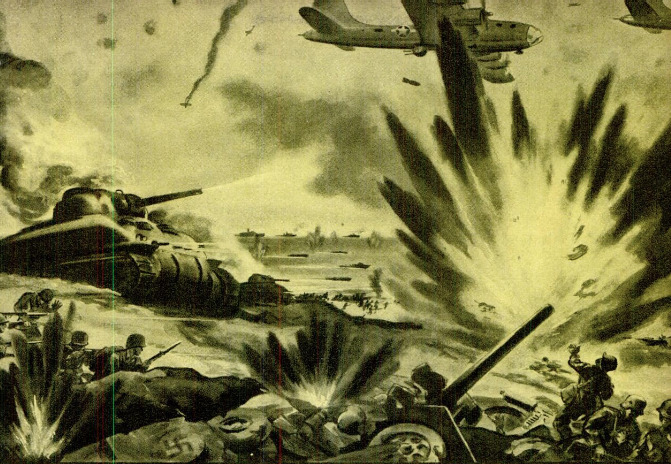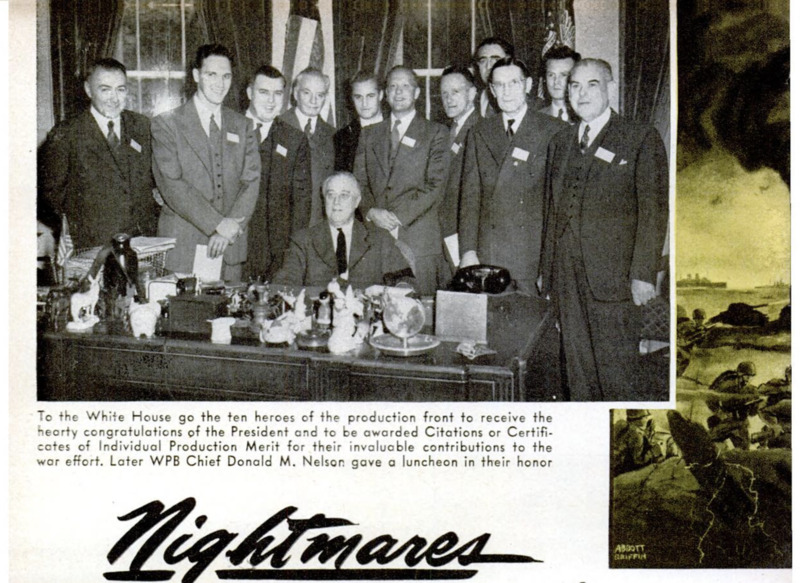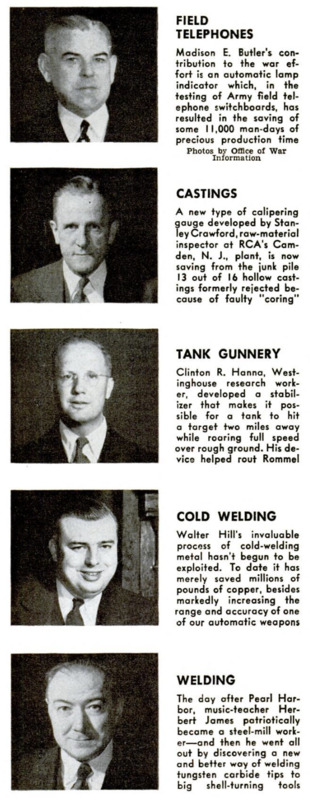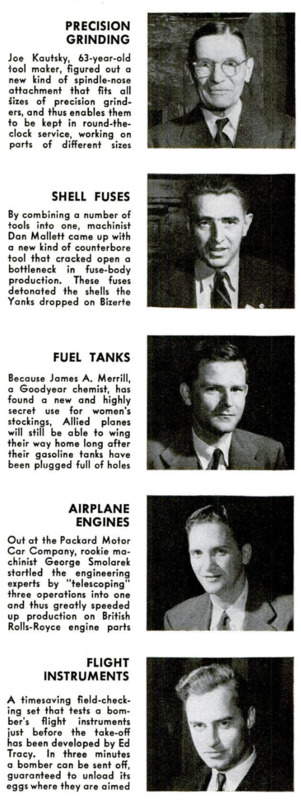-
Titolo
-
Nightmares to order-for Hitler. The History of Ten Production Heroes whose "Brain Children" Have Become Headaches for the Axis.
-
Article Title and/or Image Caption
-
Nightmares to order-for Hitler. The History of Ten Production Heroes whose "Brain Children" Have Become Headaches for the Axis.
-
extracted text
-
IT REQUIRES no great imagination to re-
| construct the scene at Hitler's headquar-
ters on the night that the British Eighth
Army blew the lid off at El Alamein. Rom-
mel had just sent a wire to his boss, saying
he had that mouthy little squirt, Mont-
gomery, backed up against Alexandria and
was about to blast him with those invincible
German 88-millimeter tank guns and then
sweep all North Africa bare of British re-
sistance with a thousand tanks flying the
black swastika. Heil Hitler!
So the little house painter who had painted
whole cities red with human blood crawled
into bed to dream of his coming triumph on
the morrow. Before dozing off, he had a few
little details to decide. . . . No, he wouldn't
head the triumphal parade through the
streets of Alexandria. That might interfere
with a previous date to stand in Red Square
in Moscow and watch the Kremlin go up in
flames. Let the little fathead Mussolini play
stooge for him at Alexandria. Now for a
good night's sleep.
But shortly after dawn the arch murderer
of all time was wakened by an apologetic
aide bearing a dispatch from Rommel.
It read: "Two-thirds of my tanks de-
stroyed by new secret weapon of the enemy.
Making strategic withdrawal to Halfaya
Pass, where I propose to ambush and de-
stroy the British Eighth Army. Heil Hitler!"
That morning Hitler's breakfast consisted
solely of the fringe of his bedroom rug,
which he tore off in great mouthfuls in frus-
trated rage. They can't do this to me—me,
The Fuehrer!
Just the same, the British Eighth Army
had done it. But not entirely on its own. Six
thousand or more miles away, in the buzzing
war factories of the United States, ten
Yankee mechanics and engineers had each
furnished an idea which put an end for all
time to Hitler's nights of dreamless sleep.
Which one of these ten Yanks deserves the
title of chief sleep buster to Hitler is neither
here nor there. It was the combination of
their ideas, skillfully employed by their
tough fighting comrades of the British
Eighth Army, that robbed Hitler of a vic-
tory already counted in the bag and even-
tually made second-hand merchandise out of
every gun and plane and tank with which
Rommel had started out to tour Africa.
Perhaps the most spectacular of these |
Yank ideas was the one contributed by Clin-
ton R. Hanna, of the vast Westinghouse
arsenal at East Pittsburgh. A hair-raisingly |
short time—as the Army measures such
events—before the Battle of El Alamein, re-
search worker Hanna left the East Pitts-
burgh plant for one of the ordnance proving |
grounds with a new device almost as com-
plicated as the now famous Norden bomb-
sight. |
The device was transferred to a waiting
tank. Hanna pulled on a suit of coveralls,
fitted on a tanker's helmet, and crawled
aboard.
The big tank lurched into motion, rum-
bling toward the crest of a low ridge. Beyond
that ridge, about two miles away, was the
target, a board shack about the size and |
shape of a German tank, built low to the
ground and no easy mark to hit. Up the
back slope raced the tank, with Hanna |
strapped in the gunner's seat, the ponderous
war machine roaring and grinding and
lurching erratically. Then over the top! |
Suddenly, Hanna's finger closed on the
trigger. The tank's heavy gun dived back
on the recoil slide. The tank commander
stopped his machine and peered down below
at Hanna.
“What's the matter, mister? Your finger
slip?”
“No, Captain. We were on the target. So
I let go.”
Just then a walkie-talkie observer, sta-
tioned in a bombproof shelter close to the
target, piped up: “Direct hit. Target de-
stroyed. Proceed to next firing problem.”
How can the new Hanna-equipped Ameri-
can tank make direct hits on enemy tanks
two miles away while on the gallop?
The answer lies in a robot known as a gyro-
stabilizer, which keeps the gun barrel at
a fixed elevation and the target in focus
of the gunner’s telescopic sight despite the
pitch of the tank. The gunner can fire
quickly and effectively, making only slight
manual adjustments when necessary.
Without knowing at the time what a wow
of an idea bit him, Dan Mallett, a machinist
in the Borg-Warner Mechanics Universal
Joint plant at Rockford, Ill, pitched another
Yankee strike over the pan in that
same battle. After the British Eighth
Army had retreated for the last time,
back from Tobruk to El Alamein, it
was short of tanks, short of guns,
and desperately short of shells. Every
resource of the United States was
strained to the utmost to re-equip the
British Eighth Army before it was
too late.
Dan Mallett’s contribution was an
idea for a new counterbore tool that
opened wide a bottleneck in fuse-
body production. Dan's idea was
simple—just combining several dif-
ferent tools into one. But nobody, in-
cluding the company’s high-salaried
production engineers, had thought of
it before. Yes, Dan Mallett, hard-
fisted Yank mechanic, pitched one
down the groove that helped blast
Rommel out of El Alamein and kept
him back-pedaling for 1,600 miles.
More shells, with Dan Mallett’ per-
sonal sentiments attached, drove the
German tanks back at Kasserine
Pass; they kept on coming in in-
creasing quantities until the Yank
Second Army had to race like hell to
beat the British Tommies—also
pitching fuse bodies a la Mallett—
into Bizerte.
Bad news 1s supposed to come in |
threes. Yes, and then some, maybe.
Joe Kautsky, a 63-year-old toolmaker
for the Link Belt Company, of In-
dianapolis, Ind., is entitled to claim a |
little credit for giving Hitler at least
one bad night.
Joe's company was making small
hardened and ground precision parts
for any of the big prime contractors
who wanted them made “close” and
made right. The only trouble was
that contractors for both tanks and
airplane engines, for instance, wanted
at the same time all the production
available from the same size grind-
ing machines in Joe's plant. That
meant that some days a number of
the larger grinding machines would
stand idle while the smaller machines
were smoking hot from overloading.
Joe devised an entirely new type of
spindle-nose attachment that would |
fit all sizes of machines, so that they
could all be thrown into production
of any size part. Joe's spindle-nose
attachment is now being used all
through the war-production program.
Heil Hitler! |
Coming in on a wing and a pray-
er—! The Yank Flying Forts are
able to do that, even with bullet holes
through every gas tank, because
James A. Merrill, research chemist
for the Goodyear Tire and Rubber
Company, found another use for
ladies’ stockings. That is all censor-
ship will permit. One of Hitler's
worst nightmares.
And just as though it weren't a
dirty enough trick to play on Hitler,
keeping the Flying Forts flying after
they were shot full of holes, along
comes another Yank with an idea
hotter than a depot stove for keeping
their bombs dropping smack on their
targets. Edwin C. Tracy, field service
man for the RCA Manufacturing
Company, Camden, N. J., plant, has
developed a field-checking set that
can be lugged right into a bomber
Just before taking off, so that its
flight instruments can be calibrated
to frog-hair accuracy. Now, in three
minutes’ time, instead of the many
days required to dismantle a plane's
flight instruments and put them
through elaborate laboratory tests,
Ed Tracy's checking instrument can
send a bomber roaring off the run-
way with every bomb guaranteed to
1and where the bombardier points his
Norden bombsight. The only one left
guessing is Hitler.
Walter P. Hill, a former turret-
lathe operator and automobile-repair
mechanic, and now a development
engineer for the Wolverine Tube Di-
vision of Calumet and Hecla Con-
solidated Copper Company, of De-
troit, has staged a one-man blitz all
his own and there would be dancing
along Unter den Linden tonight if
Walter would only develop a perma-
nent case of amnesia and forget all
he knows about how to make cold
metal weld itself to cold metal.
Reduced to its simplest elements,
Hill hit upon the idea of taking a
brass tube and, with a small tool that
costs about two dollars or less to
make, closing the end of the tube
without the use of any externally ap-
plied heat, such as from a weider's
torch or a brazing flame. He starts
with a cold plece of metal and finish-
es with one end of the tube closed in
a perfect metallurgical weld. After
he had worked the bugs out of his
process on brass tubing, he discov-
ered the same process worked on
steel tubing!
There is no limit in sight, yet, for
applications of the Hill process for
cold-welding metal. At least a half
dozen appli-
cations of it to war matériel are hush-hush
subjects of test at the Army and Navy prov-
ing grounds.
Another of the Unholy Ten—Berlin pa-
pers, please copy—who have been giving
Hitler frightful nightmares is a former
music teacher. The day after Pearl Harbor,
Herbert Rudolph James turned over his class
of music pupils to another teacher and took
a job as a steel-mill worker at the National
Tube Company, McKeesport, Pa. His boss
tried to teach Herbert James how to weld
tungsten carbide tips on big shell-turning
tools. But, frankly, Herb thought his boss
turned out a lousy job, for a little while
after the expensive tip had been welded to
the tool shank, the shell-lathe hand came
back with it—broken at the weld.
At that point Herb took off on his first
solo flight as a war-production idea man.
He rigged up an iron-pipe frame and
clamped three acetylene torches to it so that
the flame from each would play directly on
the tool. Then with all three torches going,
he thrust a tool shank and tungsten carbide
tip into this atmosphere of incandescent gas
—and out came a perfectly welded tool that
outlasted the single-torch-welded tool sev-
eral times. The same result could have been
obtained from an atmosphere-controlled
electric furnace, sure. But such furnaces
were not available. So, another spook under
the bed at Berchtesgaden.
Out at the Packard Motor Car Company,
27-year-old George Smolarek one day took a
series of operations laid out by the Packard
professional engineers and telescoped three
of those operations on a British Rolls-Royce
airplane-engine part into one operation. It's
a crime how many times since George
Smolarek pulled that idea out of his cap
those Packard-built Rolls-Royce engines
have plastered the daylights out of the
German Luftwaffe.
Yes, an idea can kill farther than a bullet.
Stanley Crawford, a sharpshooting raw-ma-
terial inspector at the RCA Camden, N. J.,
plant, saw entirely too many castings being
junked because the cored interior was not
in proper relation to the outside surfaces.
This trouble was caused by the cores float-
ing after the hot metal was poured into the
molds at the foundry. Such castings failed
to clean up in subsequent machining opera-
tions, at a great loss in both material and
priceless man-hours. Crawford designed a
special type of calipering gauge which de-
termines the relationship between the in-
side and outside surfaces of a casting, ena-
bling the machine operator to “favor” any
shifting of the core. By the use of this
caliper, 13 out of the 16 castings formerly
rejected in raw-material inspection, or
junked on the machine line, are now saved.
Just that much more Yankee hardware
headed Hitler's way.
The man who has probably caused more
“talk” than any other Yankee mechanic in
this war is Madison E. Butler, an assistant
chief inspector of Stromberg-Carlson Tele-
phone Manufacturing Company, Rochester,
N. Y. He was assigned to the job of testing
field-telephone switchboards. When the first
board came off the line, it took Butler and
an assistant five whole days, with plenty
of overtime, to check its maze of circuits.
And there were 1,100 more following closely
on its heels!
When Butler joined the Unholy Ten who
were called to the White House and con-
| gratulated for their individual contributions
to the hell-for-leather drive to manufacture
more nightmares for the Nazis, this is how
his citation read: “You have earned this
high honor by developing an automatic
lamp-indicator for testing Army field-tele-
phone switchboards, thereby saving 11,000
man-days.” Figure that out and it amounts
| to almost enough men to form a streamlined
mechanized division for one day of battle.
In other words, Butler came to bat with a
foxy test rig with which one man could do a
Detter Job of testing a switchboard in less
than two hours, compared to the original
| testing time of two men sweating out over-
time for two days.
Meanwhile, the great American pastime of
manufacturing nightmares to order for Hit-
ler and his chums goes on. The records of
the Production Idea Exchange Branch of
War Production Drive Headquarters, the of-
ficial agency of the War Production Board
charged with the job of digging out these
unsung heroes of the Production Front and
plowing their ideas back into all possible
war production channels, shows that well
over 100,000 smart Yankee production ideas
have been pulled out of the hats of American
war workers. An impressive percentage of
these ideas have been outstanding, such as
the ten described in this article. More are
turning up every day.
Is it any wonder that the man who could
sleep like a baby with the murders of mil-
lions of innocent victims on his conscience
now is having the heebie-jeebies every night
when he pulls the covers over his ears?
-
Autore secondario
-
Ray Millholland (writer)
-
Lingua
-
eng
-
Data di rilascio
-
1943-10
-
pagine
-
74-77, 202, 204
-
Diritti
-
Public Domain (Google digitized)
-
Archived by
-
Matteo Ridolfi
-
Alberto Bordignon (Supervisor)







